National Guard Empowerment
NGAUS has worked to ensure that National Guard leaders have an enhanced voice and position in the Department of Defense decision-making process. In 2008, NGAUS worked with Congress to pass Empowerment I, elevating the Chief of the National Guard Bureau (CNGB) from a three-star to a four-star general. NGAUS celebrated the victory, but didn’t stop there. In 2011, NGAUS successfully pushed for Empowerment II, which provided a seat for the CNGB on the Joint Chiefs of Staff and re-established a three-star Vice Chief position, an effort that’s considered the most significant legislative victory since the Militia Act of 1903 created the modern, dual-mission National Guard.
GI Bill 2.0 – Post 9/11 GI Bill for National Guard
In 2008, Congress passed the Post-9/11 GI Bill, with significant improvements to the original GI Bill. The Post-9/11 GI Bill was hailed as a vital step forward for the armed services, allowing qualifying members to use GI Bill benefits and reflecting the changes in duty that have been observed since 9/11. Due to its expeditious passage, the bill left out National Guardsmen and their service time. NGAUS worked with our Congressional partners to quickly correct the oversight and recognize Title 32 duty, with benefits starting at 90 aggregate days.
Overturning Proposed Air National Guard Cuts
In 2012, the Air Force shocked Congress and the National Guard community by announcing drastic cuts to the Air National Guard, including more than 5,000 personnel and 200 aircraft. NGAUS, the Council of Governors and our members argued that the Air Force was disproportionally applying cuts to the National Guard, which would harm our ability to respond domestically and abroad. After months of debate, Congress agreed with NGAUS and halted most of the proposed personnel and aircraft cuts to the Air National Guard.
Modernizing the Army National Guard
Over the past 10 years, the Army National Guard has contributed nearly half of all Army troops on the ground in Iraq and Afghanistan and has assumed an increased role in homeland defense missions. Yet as recently as 2005, the Army National Guard faced a severe equipment shortage, with only 40% of the required equipment available to them. NGAUS has worked for increased procurement funding, proportional equipping and modernization and increased National Guard and Reserve Equipment Account (NGREA) funding to close to gap and bring the ARNG to an almost 90% Equipment-on-Hand (EOH) level today.
Other notable legislative successes:
- Historic levels of National Guard and Reserve Equipment Account (NGREA) and Military Construction (MILCON) funds
- Robust Personnel and Operations and Maintenance (O&M) funding to maintain an operational reserve
- Maintained ANG end strength of 105,700 and ARNG end strength of 358,200
- Behavior health support for members of the Reserve Component during scheduled unit training assemblies
- Reemployment rights for Title 32 National Guard duty
- Expansion of state licensure exceptions for certain health care professionals to provide access to healthcare for National Guard soldiers in rural and remote areas
- Halted Air Force attempt to reassign Air National Guard C-130s into an active-component unit in Little Rock, AR
- Authority to temporarily hire non-dual status technicians to fill vacancies created by the mobilization of a dual status technicians
- Authority for the VA to provide mental health care for veterans and their families — post deployment
- Extended TRICARE coverage for “Gray Area” retirees
- Doubled from 90 to 180 days the time a Reserve Component member is covered under TRICARE Prime prior to mobilization
- Increased full-time support personnel for the Army National Guard including the largest increase for Active, Guard and Reserves (AGR) in 22 years


